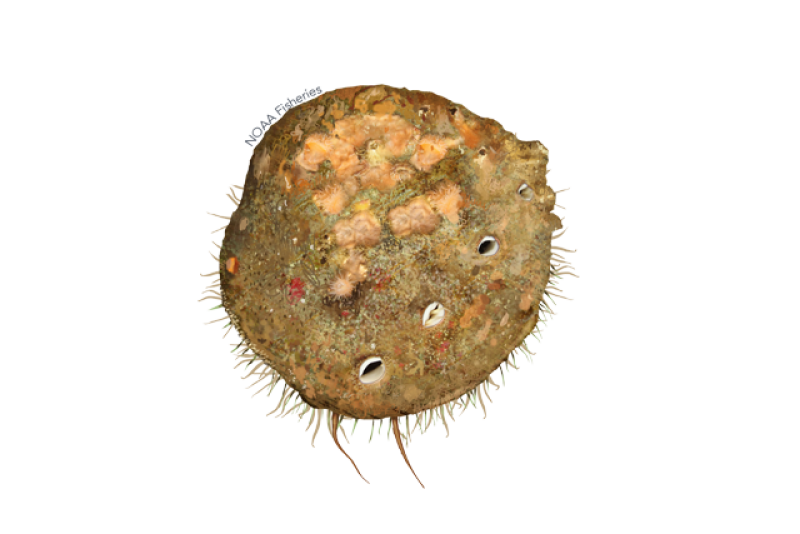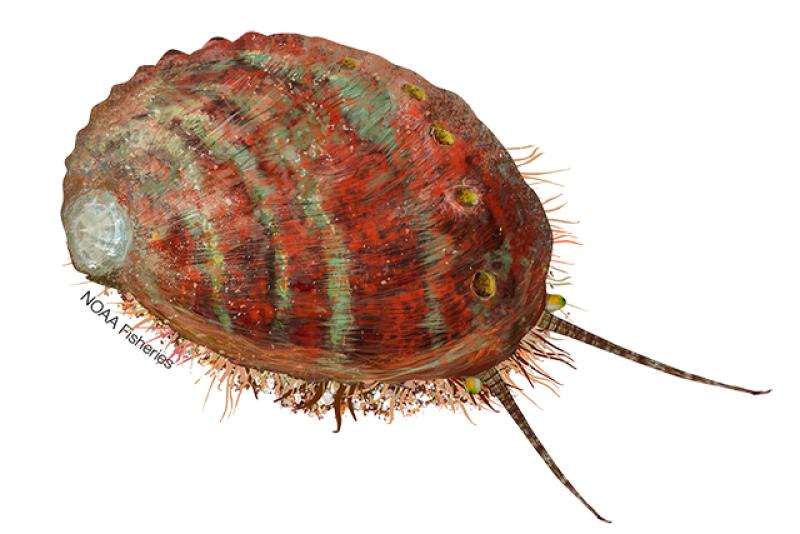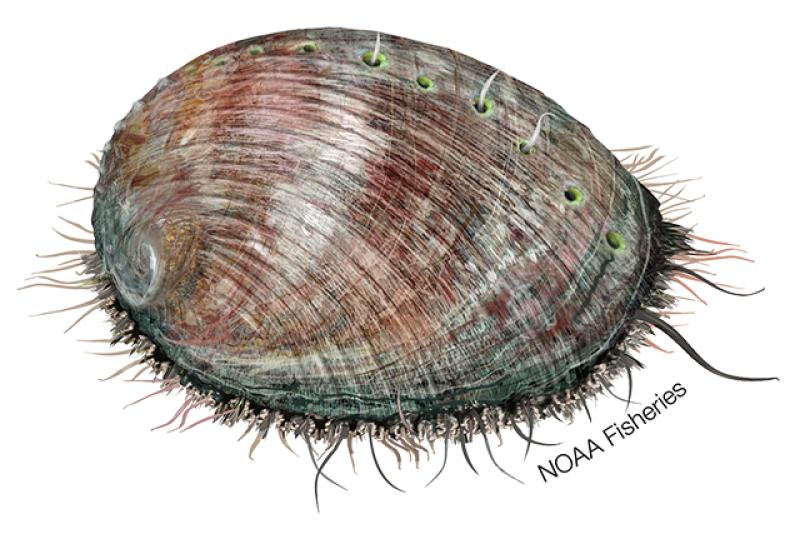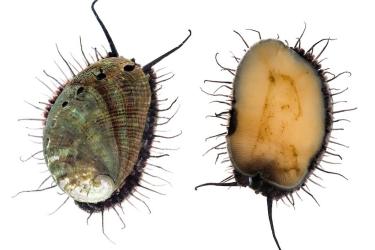Black Abalone
Haliotis cracherodii
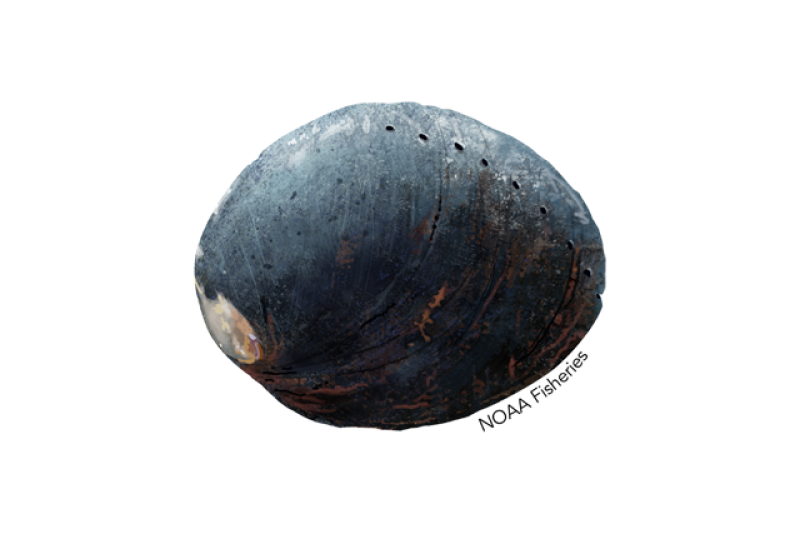
Protected Status
Quick Facts
 Black abalone. Credit: NOAA Fisheries
Black abalone. Credit: NOAA Fisheries
Black abalone. Credit: NOAA Fisheries
About the Species
 Black abalone. Credit: NOAA Fisheries
Black abalone. Credit: NOAA Fisheries
Black abalone. Credit: NOAA Fisheries
Black abalone belong to a group of algae--eating marine snails that were once common in California. They once numbered in the millions along the California coast, but are now endangered.
Native people along California’s coast ate abalone for thousands of years and large groups of abalone shells indicating human settlement, or “middens,” date back 7,400 years. Abalone shells were also traded along routes starting in southern California and reaching east of the Mississippi River.
Black abalone continue to live in rocky intertidal and subtidal reefs along the California and Baja California coast. They are “broadcast spawners,” releasing eggs and sperm into the water by the millions when environmental conditions are right. Their strong, muscular “foot” allows them to attach to rocks and other hard surfaces while their oval-shaped shells protect them from predators. Although fishing for black abalone has been illegal in California since 1993, the high price of abalone meat makes them a target of poachers. This species has experienced major declines in abundance throughout the southern California coast because of historical overfishing and mass mortalities associated with a disease known as withering syndrome.
NOAA Fisheries is dedicated to conserving and restoring black abalone. Our scientists use innovative techniques to study, protect, and restore their populations. We also work with our partners to ensure that regulations and management plans are in place to reduce poaching and increase the wild abalone population.
Population Status
Black abalone had been important to commercial and recreational fishing in California since the mid-1800s, commercial fishery landings peaked in 1973 at nearly 2 million pounds. By 1993, both commercial and recreational fisheries for black abalone closed because of significant population declines throughout southern California, primarily due to mass mortalities associated with disease (withering syndrome).
Black abalone populations have been monitored throughout the California coast from the mid-1970s to today, providing the primary source of information on the species’ status and trends over time. Healthy populations remain along the Central and North-Central California coast, but have experienced declines and loss of habitat due to recent landslides and other sedimentation events. South of Point Conception, populations in most locations persist at low densities or have become locally extinct. Since the early 2000s, however, black abalone have been observed for the first time in many years at several sites throughout southern California and have even increased in numbers at a few locations, including signs of population growth in some areas of Baja California.
Recovering the species will involve protecting the remaining healthy populations to the north, restoring disease-impacted populations to the south, continuing long-term monitoring throughout the species’ range, and conducting research on the species’ biology and response to threats, such as disease and oil spills, to inform management and conservation actions.
Appearance
The black abalone is a marine snail with one large, oval-shaped shell and a muscular foot used to move and to hold tightly to rocks. The blackish-blue shell typically has five to nine respiratory pores (holes) used to breathe, remove waste, and reproduce. It also has a solid black-colored epipodium, an extension of the foot with tentacles used to sense the surrounding environment.
Behavior and Diet
Abalone are slow-moving bottom-dwellers. They adhere to rocks and other hard surfaces using their muscular foot. When disturbed, they become difficult or impossible to remove. An abalone can also use its foot to move across surfaces. Black abalone are generally found in rock crevices.
Adults eat different types of algae. They can catch kelp drifting along the seabed or attached to rocks. Black abalone feed on giant kelp and feather boa kelp in southern California (south of Point Conception) habitats, and bull kelp in central and northern California habitats.
Where They Live
Black abalone live on rocky substrates in intertidal and shallow subtidal reefs (to about 18 feet deep) along the coast. They typically occur in habitats with complex surfaces and deep crevices that provide shelter for juveniles and adults. Because they occur in coastal habitats, black abalone can withstand extreme variations in temperature, salinity, moisture, and wave action. Black abalone range from about Point Arena, California, to Bahia Tortugas and Isla Guadalupe, Mexico. They are rarely found north of San Francisco and south of Punta Eugenia. In the mid-1900s, black abalone abundances were highest south of Monterey, particularly at the Channel Islands off southern California. Beginning in the 1980s, the spread of withering syndrome caused mass mortalities, leading to dramatic declines in black abalone throughout the southern portion of the range. Today, populations in southern California remain at low densities, with signs of natural recruitment and increasing numbers at a few sites. The status of the species in Mexico is not as well knownbut is also depleted compared to historical levels due to overfishing and disease.
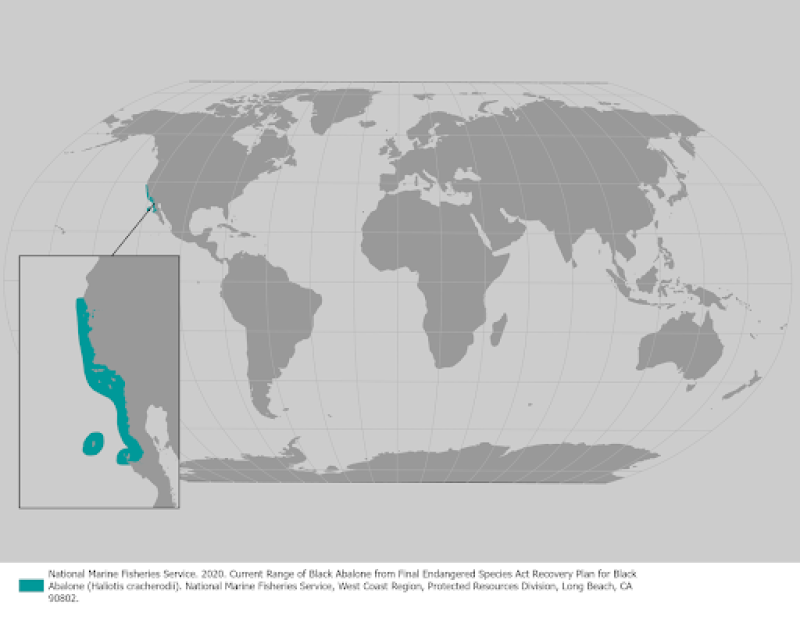 World map providing approximate representation of the black abalone's range.
World map providing approximate representation of the black abalone's range.
Lifespan & Reproduction
Black abalone are estimated to live up to about 30 years. Adults become sexually mature in the wild when they reach about 2 inches in shell length.
Abalone reproduce by broadcast spawning—releasing their eggs and sperm into the water. The eggs hatch after only one day if fertilized, but large amounts of sperm are needed to fertilize an egg. This means fertilization succeeds more often when groups of adult male and female abalone are close to each other when they spawn. Fertilized eggs hatch into swimming larvae, which settle to benthic habitat after ~7 days and grow into adults.
Threats
Overfishing
Due to their mating strategy, abalone can be depleted by intense fishing that targets groups of animals.
A commercial fishery for black abalone in California began in the early 1950s, peaked in the mid-1970s, and closed in the 1990s. The fishery used size and season limits to reduce the number of abalone caught. Even with these protections, the fishery greatly decreased the abalone populations and has had long-term effects on their recovery.
Illegal harvest (poaching) of black abalone continues to be a problem, particularly along remote stretches of the central California coast where numbers of black abalone are relatively high. Illegal harvest reduces black abalone abundance in the wild, further reducing the ability of populations to reproduce and sustain themselves over the long-term.
Disease
Withering syndrome is the primary threat to black abalone. The disease is a common and fatal infection that affects the digestive organs of abalone. The pathogen that causes it is currently present in the coastal oceans of California. Although all wild black abalone are likely infected, full manifestation of the disease appears to be more prevalent in the southern portion of the black abalone range (south of Point Conception, California) where water temperatures are relatively warmer. Die-offs from disease are associated with sea surface warming events (e.g., El Niño events, thermal discharges). The disease’s northward progression poses a continuing threat to the remaining healthy populations; however, the impacts may be reduced due to the potential for black abalone to develop genetically-based disease resistance, as well as the existence of a phage that infects the pathogen and improves the survival of abalone.
Other abalone diseases have emerged over the past several decades in abalone populations outside of California (e.g., herpes virus, vibriosis, sabellidosis). To date, no outbreaks of these diseases have been observed in wild black abalone populations. However, black abalone may be susceptible to these diseases. Strict regulations and monitoring are needed whenever animals are imported and/or transported between facilities, to minimize the potential for introducing these diseases to wild abalone populations.
Low Densities and Reproductive Rates
One female abalone can release millions of eggs at a time, but unless the eggs come in contact with sperm from spawning males, they cannot be fertilized. At some locations, black abalone have declined to such low densities that the remaining animals are far from potential mates. In these cases, spawning in the wild is unlikely or happening at low levels, making natural recovery of severely-reduced populations a slow process.
Spills and Spill Response Activities
Black abalone live in shallow coastal habitats that are vulnerable to chemical spills, such as oil spills. Spills and spill response activities could affect black abalone populations by directly killing or injuring animals and harming their habitat. The impacts may vary widely, depending on the type and amount of material involved, the location, local environmental conditions, and the status of black abalone populations within the spill area. We cannot predict where or when spills may occur, but can minimize the risks to abalone and their habitat through careful planning and coordination on spill response activities.
Sedimentation Events
Sedimentation events can affect black abalone and their habitat through burial and runoff of toxins. In 2017, a large landslide along the central California coast buried about 1,700 meters of rocky intertidal habitat and the black abalone within the area. Severe fires along the Big Sur coast led to a massive debris flow event in 2021 that buried additional segments of the coast and black abalone populations. Additional landslides in recent years continue to affect coastal habitats and black abalone. Emergency response plans have been developed to quickly mobilize and rescue black abalone in response to future sedimentation events.
Scientific Classification
| Kingdom | Animalia | Phylum | Mollusca | Class | Gastropoda | Order | Archaeogastropoda | Family | Haliotidae | Genus | Haliotis | Species | cracherodii |
|---|
Last updated by NOAA Fisheries on 09/17/2025
What We Do
Conservation & Management
We are committed to protecting and rebuilding black abalone through conservation and recovery measures, taken in close partnership with several other organizations. Our work includes:
- Monitoring the wild population’s abundance, distribution, trends, and health, working with long-term monitoring programs throughout the coast
- Evaluating and implementing population restoration tools, including habitat restoration, translocation, and captive breeding and outplanting
- Facilitating effective and efficient responses to emergency events to save black abalone and minimize effects on their populations and habitat
- Reviewing projects that could harm black abalone and their habitat
- Educating the public about abalone and the threats they face
Science
Working in partnership with several other organizations, we study the biology, behavior, and ecology of the black abalone. The results of this research and monitoring inform management decisions and enhance recovery efforts for this endangered species. Our work includes:
- Long-term monitoring of black abalone and their habitat throughout their range
- Disease research and monitoring to understand the effects of withering syndrome on black abalone populations
- Population restoration through translocation
- Developing captive breeding techniques
How You Can Help
Know the Law
It is illegal to fish for, catch, or keep any species of abalone in California except recreational take of red abalone north of San Francisco during designated periods.
Report Poaching
Call Californians Turn In Poachers and Polluters at (888) 334-CALTIP (334-2258) if you witness anyone poaching (illegally harvesting) abalone in California.
You can also submit an anonymous tip to the California Department of Fish and Wildlife by texting "CALTIP", followed by a space and the message, to 847411 (tip411).
Report a Violation
Call the NOAA Fisheries Enforcement Hotline at (800) 853-1964 to report a federal marine resource violation. This hotline is available 24 hours a day, 7 days a week for anyone in the United States.
You may also contact your closest NOAA Office of Law Enforcement field office during regular business hours.
Featured News
 Red abalone grown at The Cultured Abalone Farm in Santa Barbara, California. Credit: The Cultured Abalone Farm
Red abalone grown at The Cultured Abalone Farm in Santa Barbara, California. Credit: The Cultured Abalone Farm
 Black abalone are an endangered marine snail that face climate change threats such as increased water temperatures, sedimentation, and ocean acidification. Credit: NOAA Fisheries.
Black abalone are an endangered marine snail that face climate change threats such as increased water temperatures, sedimentation, and ocean acidification. Credit: NOAA Fisheries.
 Bull kelp forest off the coast of California. Credit: Chad King/Monterey Bay National Marine Sanctuary/NOAA)
Bull kelp forest off the coast of California. Credit: Chad King/Monterey Bay National Marine Sanctuary/NOAA)
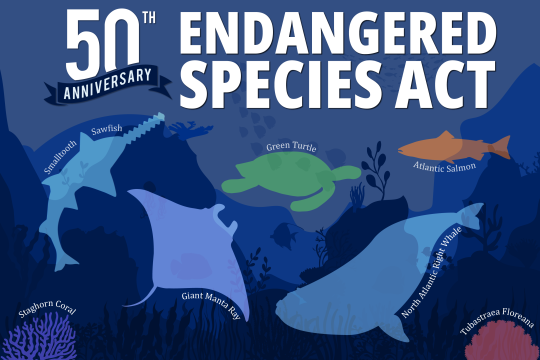
The Endangered Species Act: 50 Years of Conserving Species
Management Overview
Black abalone are protected under the Endangered Species Act. NOAA Fisheries is working with many partners to monitor the status and habitats of wild black abalone and protect this species in many ways, with the goal of rebuilding their populations.

Recovery Planning and Implementation
Recovery Action
NOAA Fisheries published a recovery outline in September 2016 (PDF, 30 pages) and a final recovery plan in November 2020. The final black abalone recovery plan describes the recovery goals, objectives, criteria, and actions needed to recover black abalone throughout its range in California and Baja California.
Critical Habitat
When a species is listed under the ESA, NOAA Fisheries evaluates and identifies whether any areas meet the definition of critical habitat. Those areas may be designated as critical habitat through a rulemaking process. The designation of an area as critical habitat does not create a closed area, marine protected area, refuge, wilderness reserve, preservation, or other conservation area; nor does the designation affect land ownership. Federal agencies that undertake, fund, or permit activities that may affect these designated critical habitat areas are required to consult with NOAA Fisheries to ensure that their actions are not likely to adversely modify or destroy designated critical habitat.
In October 2011, NOAA Fisheries designated critical habitat for the black abalone.
This designation includes approximately 360 square kilometers of rocky intertidal and subtidal habitat within five segments of the California coast between the Del Mar Landing Ecological Reserve and the Palos Verdes Peninsula, as well as on the Farallon Islands, Año Nuevo Island, San Miguel Island, Santa Rosa Island, Santa Cruz Island, Anacapa Island, Santa Barbara Island, and Santa Catalina Island. Within these areas, the designation refers specifically to those rocky intertidal and subtidal habitats from the mean higher high water line to a depth of -6 meters, as well as the coastal marine waters encompassed by these areas.

Conservation Efforts
Monitoring Black Abalone Populations
We continue to work with many partners at Federal agencies, State agencies, universities, and non-governmental organizations to maintain and expand long-term monitoring programs to evaluate the status and health of black abalone populations. Long-term monitoring has been ongoing throughout the California coast, in some areas since the mid-1970s, providing valuable data on black abalone abundance and density trends over time. These data form the basis for our understanding of the species’ status and are essential for tracking the species’ recovery. Specifically, this monitoring will help the species by:
- Providing data needed to assess long-term population trends and distribution
- Tracking the progress of withering syndrome along the coast, particularly during warm water events
- Detecting recruitment events, to inform our understanding of the factors affecting black abalone survival, growth, and reproduction
- Informing abalone conservation efforts, such as by providing data to evaluate the effectiveness of different restoration tools
Learn more about how we monitor black abalone populations
Boosting Abalone Populations
Black abalone populations within disease-impacted areas (e.g., southern California) remain at low numbers. Recruitment and increasing numbers have been observed in a few areas, but not at the scale or scope needed for natural recovery throughout this region. Active restoration efforts may be needed to rebuild populations. We are working with partners to develop and implement different restoration tools to enhance black abalone populations. These tools include:
- Restoring habitat conditions to promote recruitment of juveniles;
- Translocating animals from one site to another to increase local numbers and the likelihood of successful reproduction; and
- Developing captive breeding methods to grow black abalone for research and for outplanting to the wild, to restore abalone where they have gone locally extinct or where populations have severely declined.
Investment in disease monitoring, genetic testing, and ongoing research on abalone reproduction and recruitment dynamics (e.g., how the distance between individuals affects fertilization success) will be critical to guide enhancement efforts.
Providing Public Outreach and Education
We work with local schools in southern California, using presentations and interactive activities to share about the history and culture of black abalone and our current work to monitor, protect, and restore their populations. We are also working with partners throughout the coast to raise awareness about the important role of black abalone in coastal communities and how the public can take action to protect our rocky shores.
Learn more about public outreach and education by our partners
Key Actions and Documents
Last updated by NOAA Fisheries on 09/17/2025
Science Overview
NOAA Fisheries conducts research on the biology, behavior, and ecology of the black abalone. The results are used to inform management decisions and enhance recovery efforts for this endangered species.
Along with NOAA Fisheries, many groups—both in the United States and in other countries—are working to help save the black abalone. Among them are the following:
- Multi-Agency Rocky Intertidal Network (MARINe)
- Channel Islands National Park
- California Department of Fish and Wildlife
- El Centro de Investigación Científica y de Educación Superior de Ensenada (CICESE; Baja California, Mexico)
Long-Term Population and Habitat Monitoring
Long-term monitoring of black abalone populations and their habitat has been ongoing throughout the California coast, in some areas since the mid-1970s. NOAA Fisheries continues to support these monitoring programs because the data provided are critical to assessing the status and recovery of black abalone. For example, these monitoring efforts allowed researchers and resource managers to detect the mass mortalities of black abalone that occurred in the 1980s and 1990s and to track the spread of the disease through the Channel Islands and northward along the mainland California coast. Since then, continued monitoring has confirmed the local extirpation of black abalone at many sites, as well as the persistence of black abalone at several locations. Monitoring has also detected recent recruitment events and increases in black abalone numbers at a few local areas.
Efforts to expand monitoring in southern California and Baja California are underway to fill data gaps within these regions. Future monitoring may also include genetic sampling to evaluate the population structure of wild populations and additional health monitoring to assess the level of infection with the withering syndrome disease, as well as to provide early detection of other diseases among the wild population. This long-term monitoring is only possible due to the efforts of our many partners, including Federal agencies, State agencies, universities, and non-governmental organizations, that carry out field monitoring each year and maintain and manage the data so that it is accessible to researchers and resource managers.
Learn more about how we monitor black abalone populations
Disease Research and Health Monitoring
Our partners at the University of Washington, University of California Santa Cruz, University of California Davis-Bodega Marine Lab, CDFW, and CICESE have made significant advancements in disease research, including the development of novel methods to detect the withering syndrome pathogen in wild abalone and their habitat, antibiotic treatments to remove the pathogen from captive abalone, correlations between increased water temperature and increased infection and disease rates, and the discovery of a bacteriophage that infects the pathogen and increases the survival of infected abalone. We continue to work with our partners to evaluate the potential for disease resistance in black abalone (through the bacteriophage and through genetically-based resistance) and the susceptibility of black abalone to other diseases.
Learn more about black abalone and withering syndrome

Translocation Studies
Translocation (or transplanting) involves collecting black abalone from a donor site (where they are abundant) and moving them to a restoration site where there are few or no black abalone. The purpose of translocation is to increase reproduction and recruitment of black abalone at the restoration site (and adjacent areas), which may not be detectable until several years following initial translocation. The ultimate goal is to support viable, self-sustaining populations throughout the species’ range.
In 2023, researchers at the University of California, Santa Cruz, led the translocation of 248 adult black abalone from the Channel Islands to a restoration site in Santa Barbara County. Post-release monitoring indicates high survival of the translocated abalone. Partners in Mexico have also reported successful translocation efforts led by fishing cooperatives. Over the next few years, we will focus on expanding translocation efforts to key locations throughout California where restoration of black abalone is likely to spread to adjacent areas, boosting region-wide recovery.
Learn more about black abalone translocation efforts
Captive Breeding Studies
Development of a captive propagation program for black abalone would support our understanding of the early life history of black abalone, as well as provide animals for research and outplanting efforts, to enhance wild populations. The biggest obstacle, however, is the challenge of spawning black abalone in captivity. To date, successful captive spawning has been very limited and difficult to replicate. Since 2013, researchers at the Navy and now at the Southwest Fisheries Science Center have been working to develop reliable methods to spawn black abalone in captivity. Once methods have been developed, we can learn from the white abalone captive propagation and outplanting programs to inform development of such programs for black abalone.
Last updated by NOAA Fisheries on 09/17/2025
Documents
Final Black Abalone Recovery Plan (Haliotis cracherodii)
This recovery plan describes the recovery goals, objectives, criteria, and actions needed to…
Endangered Species Act 5-year Status Review of Black Abalone (Haliotis cracherodii)
The summary and evaluation of progress to date on recovery implementation of Black abalone
Data & Maps
Research
Abalone Research in the Southwest
This research focuses on our local abalone species to develop methods to support and expand commercial aquaculture in the region as well as aid in restoration programs for federally endangered black and white abalone.
Experimental Aquarium at the Southwest Fisheries Science Center
The aquarium at the Southwest Fisheries Science Center facilitates research across many species, including the endangered black and white abalone.
Genetics, Physiology and Aquaculture in the Pacific
We conduct research across multiple focal areas and species through genetic and physiological tools to provide improved data products for managers and industry.
Last updated by NOAA Fisheries on 09/17/2025
